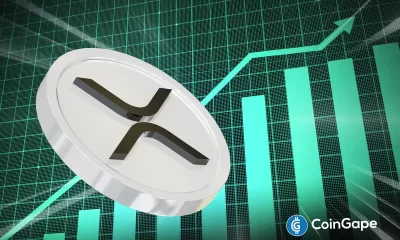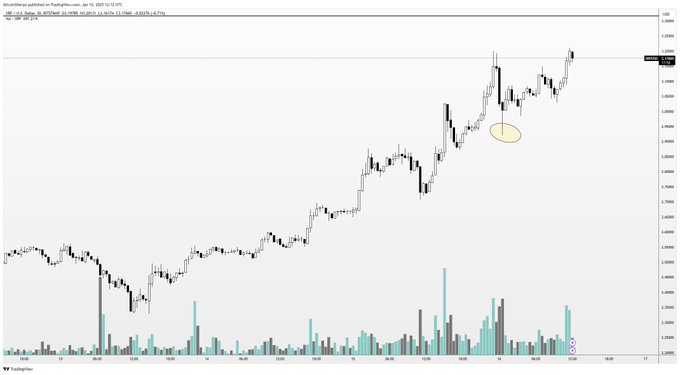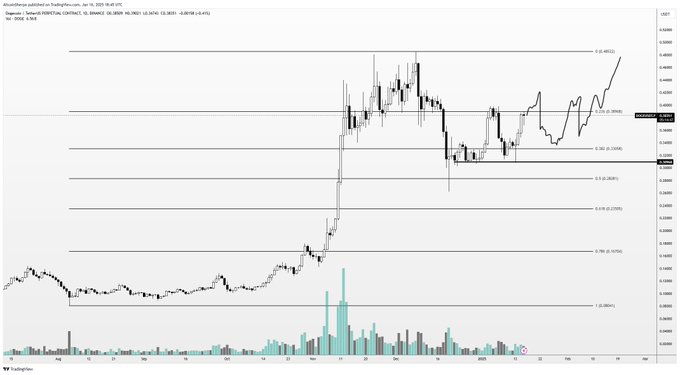analysis
Ethereum ‘Roll Back’ Suggestion Has Sparked Criticism. Here’s Why It Won’t Happen
Published
1 month agoon
By
admin

On Friday, cryptocurrency exchange Bybit was allegedly hacked by North Korea’s Lazarus group, which drained nearly $1.4 billion in ether (ETH) from the exchange.
Following the hack, Arthur Hayes, BitMEX co-founder and claiming to be a major ether (ETH) holder, wrote a post on X to Ethereum co-founder Vitalik Buterin on whether he will “advocate to roll back the chain to help @Bybit_Official.” Meanwhile, in an X spaces session, Bybit’s CEO Ben Zhou revealed that his team had also reached out to the Ethereum Foundation to see if it was something the network would consider, noting that such a decision should be based on what the network’s community wants.
Hayes’s post immediately provoked a fierce reaction from the Ethereum community, which was firm in its belief that it wouldn’t happen. Some even questioned whether the BitMEX founder was joking. CoinDesk reached out to Hayes over X to clarify his comments.
Ethereum members, like the core developer teams, are vastly against “rolling back” the network because it would override core elements of decentralization. If Buterin decided on his own that it would happen, then that would be seen as the end of Ethereum’s ethos, which heavily involves various developer teams and other community members when it comes to the health and state of the blockchain.
“Rolling back the chain would give ETH no purpose. What’s the point if you can just change rules,” said user @the_weso in a post on X.
Some outside the Ethereum community pointed to the 2016 DAO hack as an example when $60 million in ETH was stolen. The network went forward with a hard fork, splitting the old network into two, and the new chain continued on as Ethereum.
That hard fork was not a “rollback,” though; it was known as an “irregular state transition.” Ethereum technically can’t “roll back” the network because it relies on an account model, where accounts hold users’ ETH.
At the time of the hack, developers upgraded their nodes to a new client or software. Those who didn’t upgrade their nodes were still on the old chain, which became known as Ethereum Classic.
When the nodes upgraded to the new software, the stolen ETH could move from one Ethereum account address to the next.
“The ‘irregular state change’ that they implemented at the time of the DAO hard fork was this: they airlifted all the ETH in the DAO smart contracts out to a refund contract that would send you 1 ETH for every 100 DAO tokens you sent in,” wrote Laura Shin of Unchained in a post on X.
Source link
You may like


Kristin Smith Steps Down as Blockchain Association CEO to Lead Solana’s Policy Push


crypto eyes ‘good news’ amid fragile market psychology


Bitcoin Price (BTC) Rises Ahead of President Trump Tariff Announcement


XRP Price to $27? Expert Predicts Exact Timeline for the Next Massive Surge


Grayscale files S-3 for Digital Large Cap ETF


279% Rally in 2025 for One Under-the-Radar Altcoin ‘Very Likely,’ According to Crypto Analyst

Bitcoin (BTC) price has been consolidating within a roughly $5,500 range since March 9 as the $84,000 level represents stiff overhead resistance.
Data from Cointelegraph Markets Pro and Bitstamp shows BTC price oscillating between $78,599 and $84,000, as shown in the chart below.
BTC/USD daily chart. Source: Cointelegraph/TradingView
Key reasons why Bitcoin price remains flat today include:
Trump’s trade war tensions causing uncertainty in the market.
Weakening demand for Bitcoin and neutral funding rates.
BTC price remains pinned below the 200-day SMA.
Broader economic uncertainty, weakening demand
Bitcoin’s price stagnation is partially due to the broader economic and geopolitical factors that are currently at play.
What to know:
Trump’s new policies, such as his proposed trade tariffs on Mexico and Canada, have unnerved the market.
Investors, wary of inflation concerns and a potential tariff war, are avoiding risk assets like Bitcoin.
As Cointelegraph recently reported, Bitcoin’s rally post-Trump’s November election has lost steam amid a weakening global economy.
This has resulted in weaker demand for Bitcoin, according to Glassnode.
For instance, the cost basis of 1w–1m short-term holders flattened out above that of the longer-term holders (1m–3m) in Q1, “marking an early sign of weakening demand in the immediate term.”
Related: Bitcoin price drops 2% as falling inflation boosts US trade war fears
Bitcoin’s drop below the $95,000 level saw the 1w–1m cost basis slide below the 1m–3m cost basis, “confirming a transition into net capital outflows.”
Glassnode noted:
“This reversal indicates that macro uncertainty has spooked demand, reducing new inflows… and suggests that new buyers are now hesitant to absorb sell-side pressure, reinforcing the shift from post-ATH euphoria into a more cautious market environment.”
Bitcoin STH capital flow. Source: Glassnode
Until the current trend changes due to macroeconomic tailwinds, such as Fed rate cuts, Bitcoin could struggle to break out of the current range, leaving it vulnerable to pullbacks toward $70,000.
Another clear signal of Bitcoin’s stagnation is in the perpetual futures funding rates. BTC funding rates, which reflect the cost of holding long or short positions in crypto futures, are hovering close to 0%, indicating increasing indecisiveness among traders.
Bitcoin perpetual futures funding rates across all exchanges. Source: Glassnode
Without speculative fuel, Bitcoin is struggling to move in either direction, leaving its price stuck in a tight range as traders wait for the next catalyst.
Bitcoin price faces stiff resistance on the upside
Bitcoin also trades below key resistance areas, as shown in the chart below:
On March 9, BTC fell below the 200-day simple moving average (SMA) at $83,736.
This trendline has stifled the latest efforts for a sustained recovery.
BTC/USD daily chart. Source: Cointelegraph/TradingView
Popular crypto analyst Daan Crypto Trades says that the 200-day SMA at around $83,700 and the 200-day EMA at $86,000 are key levels as they are “solid indicators of the mid/long term trend and overall strength of the market.”
In other words, failure to produce a decisive close above the 200-day SMA and flipping it into a new support level could lead to a longer consolidation period for Bitcoin price.
This article does not contain investment advice or recommendations. Every investment and trading move involves risk, and readers should conduct their own research when making a decision.
Published on By A relatively new Ethereum (ETH) layer-2 scaling solution has soared to the top of Santiment’s rankings of ERC-20 coins in terms of recent development activity. The crypto analytics firm notes that Starknet (STRK) clocked 401.97 notable GitHub events over the past 30 days. Starknet is a decentralized validity rollup, otherwise known as a zero-knowledge (ZK) roll-up. Rollups are solutions that execute transactions outside of Ethereum’s blockchain but record the transactional data. The project launched its token last February. STRK is trading at $0.455 at time of writing. The 119th-ranked crypto asset by market cap is up more than 7% in the past 24 hours. Starknet surged past last month’s most-developed project, the decentralized oracle network Chainlink (LINK), which registered 311.57 notable GitHub events. Ethereum itself was third, with 219.13 events. An ERC-20 project is a standard that developers use to issue tokens on the Ethereum blockchain. Santiment notes that it doesn’t count routine updates and utilizes a “better methodology” to collect data for GitHub events based on a “backtested process.” The analytics firm has previously said that heavy development activity centered around a crypto project indicates developers believe in the protocol. Development activity also suggests a given project is less likely to be an exit scam. Don’t Miss a Beat – Subscribe to get email alerts delivered directly to your inbox   Generated Image: Midjourney Published on By A widely followed analyst and trader is leaning bullish on a top-30 altcoin by market cap while outlining the path forward for three other crypto assets. The analyst pseudonymously known as Sherpa tells his 239,700 followers on the social media platform X that the utility token of the decentralized open financial system, Hyperliquid (HYPE), is likely to surge by at least 116% from the current level before the end of this cycle. “…I still think HYPE is a great project and will go to $50+ later this cycle. It just hits too many narratives and I have a bag of this (and I’m doing a little trading just to hope to get more points). Wouldn’t rush into a position here but more scale in. Not one to give you a 10x at these current levels for this cycle in my opinion but could still be a safe one to hold.” Hyperliquid is trading at $23.16 at time of writing. Next up is XRP. While observing that XRP is demonstrating strength as it sits just below its all-time high, Sherpa says that XRP is not at an ideal level for long entries. “For what it’s worth, I don’t actually recommend you buy more at this current position. It’s at former all-time high and this is a natural retracement point. Think you should be patient with it. I’m going to wait a bit before adding and hope it dips.” Next up is Cardano (ADA). The analyst says Cardano appears “pretty strong” on the weekly time frame and could continue to go up as long as other first-generation altcoins continue to appreciate. Turning to Dogecoin (DOGE), Sherpa says the largest memecoin by market cap “looks strong still.” According to Sherpa, Dogecoin could trade in a range for a while before revisiting the 42-month high of around $0.485 reached in December. Dogecoin is trading at $0.412 at time of writing. Don’t Miss a Beat – Subscribe to get email alerts delivered directly to your inbox   Generated Image: Midjourney Arthur Hayes, Murad’s Prediction For Meme Coins, AI & DeFi Coins For 2025 Expert Sees Bitcoin Dipping To $50K While Bullish Signs Persist Aptos Leverages Chainlink To Enhance Scalability and Data Access Bitcoin Could Rally to $80,000 on the Eve of US Elections Sonic Now ‘Golden Standard’ of Layer-2s After Scaling Transactions to 16,000+ per Second, Says Andre Cronje Institutional Investors Go All In on Crypto as 57% Plan to Boost Allocations as Bull Run Heats Up, Sygnum Survey Reveals Crypto’s Big Trump Gamble Is Risky Ripple-SEC Case Ends, But These 3 Rivals Could Jump 500x
Source link Altcoin
New Ethereum Layer-2 Scaler Soars to Top of Santiment’s Rankings of ERC-20 Coins by Development Activity

Check Price Action
Follow us on X, Facebook and Telegram
Surf The Daily Hodl Mix
Disclaimer: Opinions expressed at The Daily Hodl are not investment advice. Investors should do their due diligence before making any high-risk investments in Bitcoin, cryptocurrency or digital assets. Please be advised that your transfers and trades are at your own risk, and any losses you may incur are your responsibility. The Daily Hodl does not recommend the buying or selling of any cryptocurrencies or digital assets, nor is The Daily Hodl an investment advisor. Please note that The Daily Hodl participates in affiliate marketing.
Source link Altcoin
Trader Says One Large-Cap Altcoin To Skyrocket by at Least 116%, Updates Outlook XRP, Cardano and Dogecoin

Check Price Action
Follow us on X, Facebook and Telegram
Surf The Daily Hodl Mix
Disclaimer: Opinions expressed at The Daily Hodl are not investment advice. Investors should do their due diligence before making any high-risk investments in Bitcoin, cryptocurrency or digital assets. Please be advised that your transfers and trades are at your own risk, and any losses you may incur are your responsibility. The Daily Hodl does not recommend the buying or selling of any cryptocurrencies or digital assets, nor is The Daily Hodl an investment advisor. Please note that The Daily Hodl participates in affiliate marketing.
Source link 
Kristin Smith Steps Down as Blockchain Association CEO to Lead Solana’s Policy Push

crypto eyes ‘good news’ amid fragile market psychology

Bitcoin Price (BTC) Rises Ahead of President Trump Tariff Announcement

XRP Price to $27? Expert Predicts Exact Timeline for the Next Massive Surge
Bitcoin And Altcoins Fischer Transform Indicator Turn Bearish For The First Time Since 2021

Grayscale files S-3 for Digital Large Cap ETF

279% Rally in 2025 for One Under-the-Radar Altcoin ‘Very Likely,’ According to Crypto Analyst

Human Rights Foundation Donates 1 Billion Satoshis To Fund Bitcoin Development

Dogecoin, Cardano Lead Gains as Crypto Majors Rally

Fartcoin price surges 35% as recovery gains momentum

$1M Premium Paid for $70K Bitcoin Put Option

How DePIN’s Revenue Growth is Attracting Equity Investors – DePIN Token Economics Report

Bitcoin Poised For A Q2 Recovery? Analyst Points 2017 Similarities

Binance ends Tether USDT trading in Europe to comply with MiCA rules

Crypto Trader Warns of Potential 33% Dogecoin Drop, Unveils Downside Price Target for Ethereum

Arthur Hayes, Murad’s Prediction For Meme Coins, AI & DeFi Coins For 2025

Expert Sees Bitcoin Dipping To $50K While Bullish Signs Persist

Aptos Leverages Chainlink To Enhance Scalability and Data Access

Bitcoin Could Rally to $80,000 on the Eve of US Elections

Sonic Now ‘Golden Standard’ of Layer-2s After Scaling Transactions to 16,000+ per Second, Says Andre Cronje

Institutional Investors Go All In on Crypto as 57% Plan to Boost Allocations as Bull Run Heats Up, Sygnum Survey Reveals

Crypto’s Big Trump Gamble Is Risky

Ripple-SEC Case Ends, But These 3 Rivals Could Jump 500x

Has The Bitcoin Price Already Peaked?

A16z-backed Espresso announces mainnet launch of core product

Xmas Altcoin Rally Insights by BNM Agent I

Blockchain groups challenge new broker reporting rule

The Future of Bitcoin: Scaling, Institutional Adoption, and Strategic Reserves with Rich Rines

Trump’s Coin Is About As Revolutionary As OneCoin

Is $200,000 a Realistic Bitcoin Price Target for This Cycle?
Trending






















